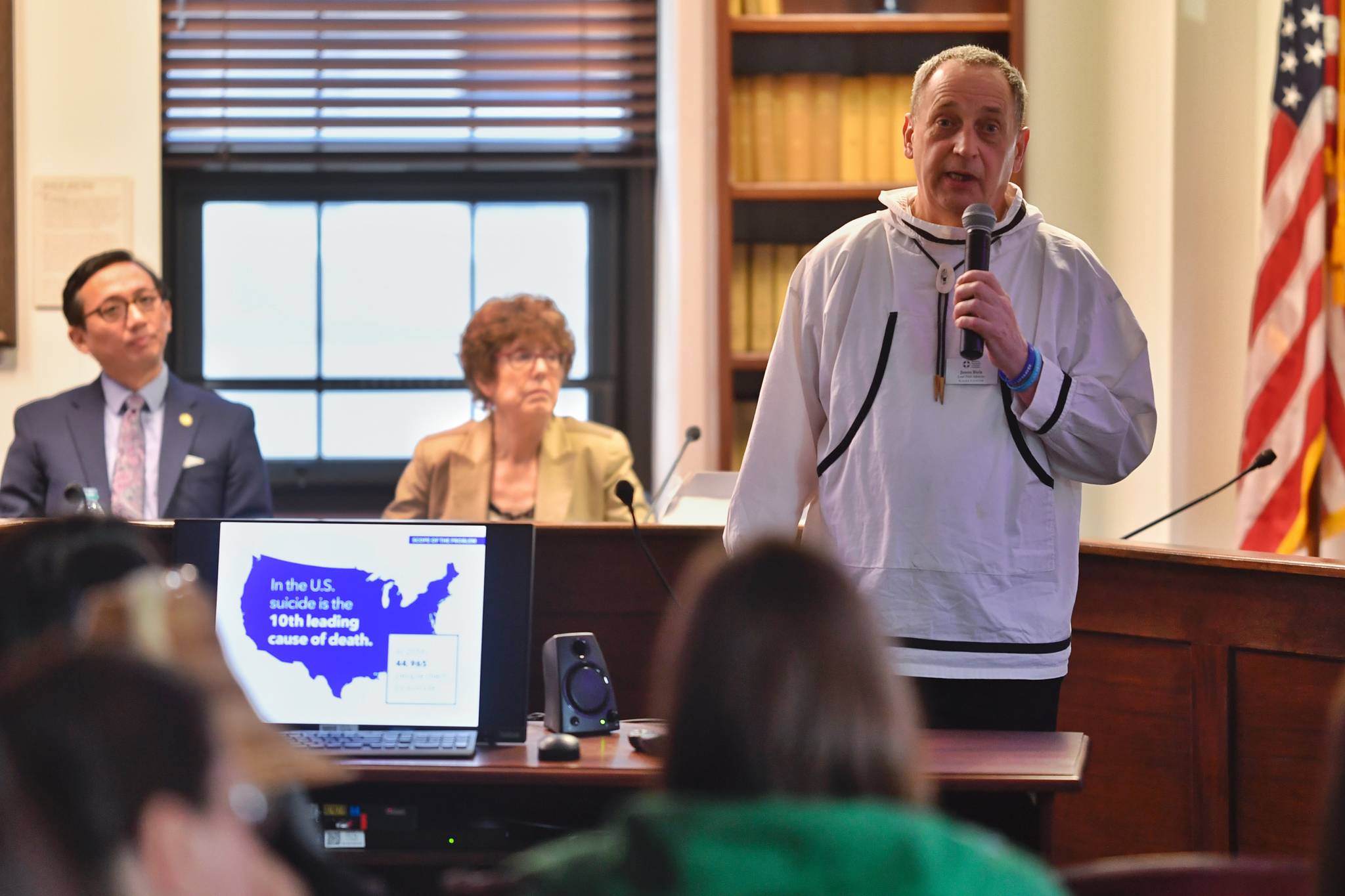There are so many factors impacting why people take their own lives. There’s no single reason why.
On Tuesday, the legislature got an introduction to suicide prevention by James Biela from the American Foundation of Suicide Prevention, where he emphasized the single most important thing people can do to prevent suicide: talk about it.
“Something very simple can be done, and that’s what we’re doing today, and that’s talk about it,” Biela said. “Talk saves lives.”
Advocates attending the three-day State Capitol Day event hosted by the AFSP met with lawmakers and urged their support of HB 22/SB 10 to extend the termination date of the Statewide Suicide Prevention Council until the year 2027. They also are hosting a candlelight vigil Tuesday night on the Capitol steps.
Biela said he’s known five people in one year who died by suicide and that someone dies by suicide every 40 seconds. It’s the 10th leading cause of death in the country.
A few hours after the presentation at the Capitol, a 64-year-old man died by suicide after jumping off Douglas Bridge, police said.
[Breaking: Authorities respond to death at Douglas Bridge]
How people talk about suicide matters, said Biela, because there’s a lot of stigma out there.
“Try to avoid using ‘he committed suicide’ instead say ‘he died by suicide,’” Biela said. “We try to avoid ‘failed or successful attempt,’ it’s either ‘suicide attempt’ or ‘death by suicide.’”
Based on 2016 data, on average one person in Alaska dies by suicide every two days, he said. It was the sixth leading cause of death in the state. But new statistics from 2019 highlight the growing problem. On average one person dies by suicide every 44 hours, versus 48 from 2016, and it’s now the fifth leading cause of death in the state.
“It’s time for organizations to come together … because for every suicide there’s 25 attempts,” Biela said. “I’ve been out here for 14-15 years, and I just realized that one suicide in a village affects the whole region, the relations, and the guilt behind it.”
[Tattoo parlor offers discounts, raise money for suicide prevention]
There was discussion about conversion therapy after a member in the audience said he believes in “Adam and Eve, not Adam and Steve.” That prompted questions from the audience about what the foundation does to help prevent suicide among LGBTQ people, since their suicide rates are generally higher than the average population.
A representative from the American Foundation of Suicide Prevention said they are pushing prohibition of conversion therapy, which is one of the leading impacting factors for LGBTQ people who commit suicide.
Contributing factors
Research has shown physical differences in the brains of people who die by suicide verses those who die for other reasons, Biela said.
“Most people who are suicidal are ambivalent about taking their life,” Biela said. “They don’t really want to die. They’re struggling with the pain that’s inside. … But their pain was too deep, and it got to be too much.”
The family history of suicide is real, Biela said. It’s one impacting factor of suicide, along with environmental factors such as access to lethal means, exposure/contagion, prolonged stress and stressful life events.
“Young people are walking around the villages and seeing someone who died by suicide from their house,” Biela said. “It’s real out there for them.”
He said contagion doesn’t have to be right away. Just in the past month, two survivors of the Parkland, Florida high school shooting died by suicide and a father of a Newtown, Connecticut school shooting victim also died by suicide. He pointed out these deaths as examples of how contagion can work.
“We all need support,” Biela said. “The most important thing you can put between a suicidal person and their way of ending their life is time. Bottom line what can you do? You need to have a conversation just like we’re having a conversation today. We need to have it open and directly, you cannot hide it.”
How to spot someone at risk
Some behaviors people exhibit when they are at risk for suicide:Increased use of alcohol or drugs
Issues with sleep
Giving away possessions
Acting recklessly
Withdrawing from activities
Isolating from family and friends
Looking for a way to kill themselves
“If there’s any change, ask, ‘Are you OK?’” Biela said. “Trust your gut. Assume you’re the only one who’s going to reach out and ask.”
How to help
He said it’s important to be direct with the question, don’t ask, ‘Are you doing to do something stupid?’ ask specifically, ‘Are you thinking of killing yourself?’ Watch their expression. They will be thankful you even asked that question, he said.
How to reach out to someone:Talk to them in private
Listen to their story
Express concern and caring
Ask directly about suicidal thoughts like ‘Are you thinking about suicide?’
Encourage them to seek mental health services — if you have to, take them with you or call the national care line
“Avoid minimizing their feelings,” he said. “Avoid trying to convince them life is worth living because they don’t care right now. Watch for the talk, the mood and the behavior.”
The AFSP also provides training for people who are looking to start a support group for survivors of suicide loss. The Suicide Prevention Lifeline number is 1-800-273-TALK. For emergencies, call 911.
Editor’s Note: Suicide is a serious topic. If you’re in trouble and need help, please talk to someone. If you don’t think you can talk to someone in person, call the Alaska CARELINE at 1-877-266-HELP, or visit the National Suicide Prevention Lifeline, the Alaska Community Mental Health Centers, or juneausuicideprevention.org.
• Contact reporter Mollie Barnes at mbarnes@juneauempire.com.

